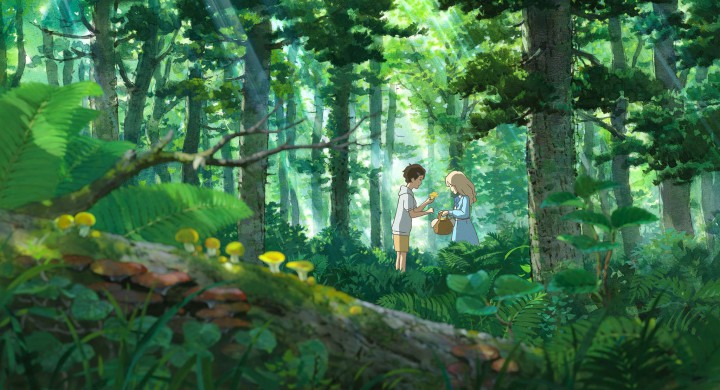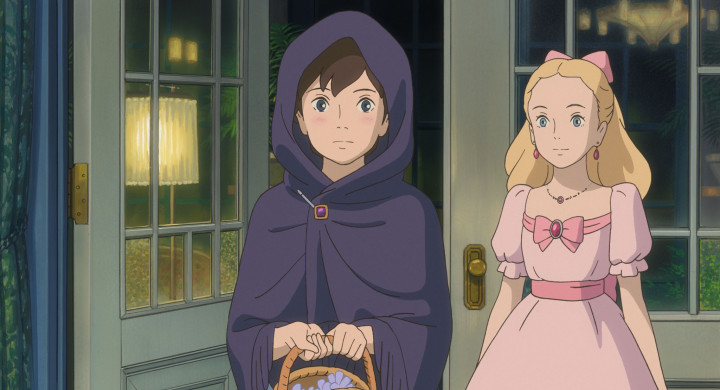If indeed Hiromasa Yonebayashi’s When Marnie Was There turns out to be the final film to come from Studio Ghibli — as has been claimed — it would be hard to imagine a more elegant or appropriate farewell. No, it’s not as big or elaborate or fantasticated as Hayao Miyazaki’s best known films like Spirited Away (2001) or Howl’s Moving Castle (2004). It isn’t even as expansive as Miyazaki’s last film, The Wind Rises (2013). This is something altogether different — a small scale, intimate film that takes place in a version of rural Japan that feels more closely related in look and topography to the film’s source novel by English writer Joan G. Robinson with its Norfolk coast setting in the east of England. Intentionally or otherwise, the film gives off a distinct vibe of farewell — as well as the sense of something from another age. Its handcrafted, watercolor look, of course, is automatically out of step with the brightly colored — almost Day-Glo — computer animation we’re used to today. But it goes deeper. Marnie gives off the feeling of an old, somewhat faded, long-forgotten book found at the back of a drawer — like something only dimly remembered.
I don’t wish to give the impression that the film is in any way depressing. It isn’t that, but it carries that special emotional sense common to stories with an end-of-an-era atmosphere. It is — I’m finding — a difficult film to write about. It’s difficult to even peg exactly what it is. On its simplest level — and this is hardly a spoiler, though some may find it so — Marnie is a ghost story. I say that’s not a spoiler because you have to be pretty thick not to figure that much out early on, but it’s the least significant aspect of the story. For a story that ultimately seems fairly simple, the film manages to touch on a surprisingly broad range of deeper issues — including child abuse, the problems of being a foster child and, most surprisingly, the undercurrent of racism that exists where mixed-race children are concerned. That last — though not stressed — is perhaps the driving force behind the film’s main theme, which is the loneliness of childhood.
The story follows Anna Sasaki (Sara Takatsuki), a withdrawn, artistic girl of about 12. Following a severe asthma attack, her foster mother, Yoriko (Kasumi Arimura), parcels her off to an aunt (Toshie Negishi) and uncle (Susumu Terajima) on the coast of rural Japan — ostensibly for the fresh air. But Yoriko also is at a loss about what to do for the introverted child, and she’s nursing a guilty secret (at least she thinks it’s a secret) concerning receiving a government subsidy for keeping Anna. No sooner is Anna in these new surroundings than she becomes fascinated by a deserted mansion that’s only accessible at high tide. It quickly becomes apparent that the mansion may not be deserted after all, and not long after that she meets Marnie (Kasumi Arimura), who becomes her first friend — and a secret one at that. What follows this unravels the mystery of Marnie and much more. It in fact gives Anna a life.
My only reservation about the film is that it’s probably too measured and sophisticated for most children, but I don’t think Marnie is so much for children as it’s about them. It’s really a film for adults. I suspect the more you’ve seen of life, the more its magic will work on you and the more resonant its individual moments will be. This is a special little film that will pay greater rewards than might at first seem probable. I should note that this review is based on seeing the original Japanese language film with subtitles. There is also a dubbed (well, all animated films are dubbed) English version. I don’t know which version will be shown, or if it will be handled the way The Wind Rises was — with different versions at different times. Rated PG for thematic elements and smoking.








This fared rather better than I expected, but not enough so to propel it to a second week. By Friday it will be gone.
Is it in the theater with the sofas?
There are actually four of those. It wasn’t originally, but it may have been moved to one, since they’re also the smallest theaters.
If it still matters, it was in no. 5 tonight, which is not a sofa theater.
Lovely, lovely movie and easily one of my favorite of the year, and this despite an English language dub that does it few favors. My reaction to the dub may have less to do with its quality than with the fact that I’m generally distracted by instances in which the language characters speak doesn’t match the setting. That said, I’m increasingly confused by the decision to focus on the English version of foreign animated films on those occasions that they do appear here; history, as far as I know it, has demonstrated that they don’t really perform well here anyway and a large percentage of the fan base for this kind of thing is often actively repulsed by English language dubs. I get that there’s a commercial need to leave the movie accessible to the widest audience possible, but that approach doesn’t appear to have worked here in the past. Then again, I can’t really think of a subtitled film that did extremely well here either, but then I don’t really follow these things as closely as I could. Which is to say I find it a shame that non-Western animated movies (and maybe non-Western movies in general) seem to struggle to find an audience in Asheville, even I don’t see how that could change.
Anyway, I think this is, as has been noted, an extremely fitting endpoint for Ghibli’s oeuvre, if it does indeed come to that. It’s a perfect embodiment of Ghibli’s tonal and thematic approach, but it’s also mostly unlike any other work that they’ve put out, especially in its almost ethereal melancholy. It seems most closely related to FROM UP ON POPPY HILL (which I don’t believe played here), but that one was much more concerned with the joy and romance of childhood than this is, even if the fear of isolation informs it pretty heavily. But this approaches that fear directly and in an extremely satisfying, emotionally compelling manner. And beyond that, it’s simply a beautifully crafted movie that captures a sense of a lived-in world despite, or maybe because of, its fantasy elements. Even though it’s not without its minor problems (the main one for me is that the relationship between Anna and Marnie feels somewhat like a nascent romance for much of the movie, which doesn’t really mesh with the way the narrative plays out, although that seems like something that will be less of an incongruity the longer I spend with the movie), its depth, resonance, and supreme warmth make it a completely lovable, engrossing film and one that deserves more support than its apparently received.
If memory serves both Spirited Away and Howl’s Moving Castle did okay here. Both were dubbed, which may or may not have been a factor, since they both had a bigger marketing push. Now, it didn’t do anything amazing at the box office but Paprika — subtitled — did okay. All those are from the pre-DCP days, meaning you got the print you got. I’d be willing to bet the DCP for Marnie offered both versions (The Wind Rises Did) and that it was the theater that opted for the dubbed print. I probably should have checked into this.
Several sub-titled films have done solid business here Pan’s Labyrinth and The Orphanage come to mind and most Almodovar does okay, but those seem curtailed more by the fact that they’re Almodovar than that they’re in Spanish. Y Tu Mama Tambien was solid. In the House did well. I seem to think that The Man on the Train and L’Auberge Espagnol did well but that was a long time ago and I didn’t really pay attention. And Holy Motors did far better than anyone had a right to expect! Asian films — high profile martial arts titles like Crouching Tiger or Hero to one side — are another matter, though I remember that Mother was a surprise hit at The Carolina (and that was when The Carolina was really struggling). Thirst, on the other hand, died. Can’t remember if I Saw the Devil did any business. (I kinda doubt it.) I’m having a hard time remembering a Japanese film that wasn’t animated. Surely, I am just not thinking clearly.
Off the top of my head, there was LIKE FATHER, LIKE SON last year. I’m pretty sure 13 ASSASSINS played here too. A very brief look at the Fine Arts’s website tells me that ZATOICHI did as well. I would be surprised if DEPARTURES never ended up making it to town, but it doesn’t look like the Fine Arts had it. There’s also TOKYO! and LIKE SOMEONE IN LOVE even if neither of them were directed by Japanese filmmakers. That’s all I can come up with.
It’s easy to imagine Almodovar and things associated with del Toro doing alright here. Out of curiosity, how has Jeunet tended to perform?
Like Father, Like Son was here. 13 Assassins actually did pretty well here. Zatoichi lasted week. Departures did play here — early days of The Carolina. I reviewed it from a screener when I was in Florida for some reason. I don’t recall if it did well or not.
As for Jeunet, Amelie was a sizable hit here. A Very Long Engagement less so. Micmacs was a modest success. The Young and Prodigious T.S. Spivet — which is in English — is still in Weinstein Hell in this country (since 2013). Having seen it, I understand why they don’t know what to do with it, but I don’t understand why they bought it in the first place. (Keep an eye out for the Sept. AFS listings…) I suppose Michel Gondry belongs here, though most of his rather eclectic filmography isn’t in French. Still Science of Sleep did so-so business and after I badgered The Carolina into booking Mood Indigo, it held up for two weeks. (Really need to run Gondry’s long version at the AFS.)
(Really need to run Gondry’s long version at the AFS.)
Yes.